NASA has rejected a warning from the outgoing members of its Aerospace Safety Advisory panel that the International Space Station is an “accident, waiting to happen.” Space station manager William Gerstenmaier said on Monday that all the teams working on the station need to have focus and attention to detail, but it’s not seriously dangerous. The safety panel pointed out that the battery pack on the station could accidentally vent into the station, which would be catastrophic – NASA acknowledged it was a risk and the Russians will be providing a safer battery design.
Meteorite Injures 20 in India
At least 20 people were injured and several homes were destroyed when a meteorite crashed into a village in eastern India. Several reports say that a fireball flew across the sky, and burning fragments rained down across a wide area. Officials are in the area now, assessing the damage, and trying to help recover pieces of the meteorite for further study.
SCUBA 2 is in Development
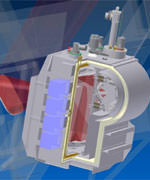
Image credit: PPARC
The Canadian Federation for Innovation announced today that it will be contributing $12.3 million CDN for the development of the SCUBA 2 project – an instrument that will be able to detect objects in the sub-millimetre wavelengths (in between radio and infrared). SCUBA 2 will be faster, imaging objects in hours instead of weeks, and it will be much more sensitive, allowing it to look further into space. Sub-millimetre astronomy is a newer field of research, which allows astronomers to penetrate clouds of obscuring dust to look at comets, the birthplace of stars, and distant galaxies.
Astronomers are poised to take another giant leap into some of the coldest regions of space following the announcement that Canada will join the UK in developing a new generation camera for the James Clerk Maxwell Telescope (JCMT) in Hawaii – the world’s largest telescope for studying astronomy at sub-millimetre wavelengths.
The announcement today (26 September 2003) of a grant of ?5.5 million (12.3 million Canadian Dollars) from the Canadian Foundation for Innovation will contribute to the development of a new instrument, SCUBA 2. The UK, through the Particle Physics and Astronomy Research Council (PPARC) will also contribute some ?4 million to the development of the instrument with a further ?2.3 million coming from the JCMT partner Agencies contributions (UK, Canada and the Netherlands).
The project is lead by the UK Astronomy Technology Centre (UK ATC) at the Royal Observatory, Edinburgh. The new instrument will supersede the original groundbreaking Sub-millimetre Common User Bolometer Array (SCUBA) frequently cited as one of the most important ground-based astronomical instruments ever. SCUBA was also designed and constructed at the Royal Observatory, Edinburgh in collaboration with Queen Mary, University of London.
Professor Ian Halliday, Chief Executive of PPARC commented “SCUBA 2 will enable the JCMT to maintain its position as one of the world’s leading facilities in the exotic field of sub-millimetre astronomy. We are delighted that our Canadian colleagues have joined with us to spearhead its development.”
Dr Wayne Holland, SCUBA 2 Project scientist at the UK ATC said “To work in this challenging field requires special techniques and cutting-edge technology. With a much larger field of view and the capability to limit background ‘noise’, SCUBA 2 will map large areas of sky up to 1000 times faster than the current SCUBA camera. Sub-millimetre detectors must be cooled to a fraction of a degree above absolute zero (-273 decrees C). The UK ATC has considerable experience of producing electrical and optical systems that deliver a high level of performance at these extreme temperatures.”
Dr Adrian Russell, Director of the UK ATC said: “SCUBA 2 will be a second revolution in sub-millimetre astronomy and will build on the ground-breaking science that its predecessor SCUBA (1) has already delivered. The JCMT community will have access to a tremendously powerful tool which will not only carry out world class science, but will put them in an enviable position to exploit the new ALMA telescope when it comes online. ”
Sub-millimetre astronomy is a new and rapidly developing field that allows scientists to probe the composition of comets, the birthplaces of stars and the most distant galaxies. Sub-millimetre wavelengths lie between those of traditional radio astronomy and those of the newer but now fairly well understood infrared astronomy. Astronomers detect light at sub-millimetre wavelengths in order to penetrate clouds of cosmic dust.
The vast majority of light from young galaxies in the distant universe is absorbed by dust, and is only observable by astronomers at sub-millimetre wavelengths. The quantity of dust in young galaxies reveals whether stars formed gradually, or mainly in sudden bursts, in the early history of the Universe.
SCUBA 2 will actually have two cameras – each operating simultaneously at a different wavelength in the sub-millimetre band. The 6400 pixels in each camera will cover an 8 x 8 arc-minute patch of sky (about a third of the full moon) or some 16 times the area of the existing SCUBA instrument. The improved sensitivity and imaging power will mean that observations that now take weeks of telescope time with SCUBA will be made in only a few tens of minutes.
Original Source: PPARC News Release
SMART-1 Launched to the Moon
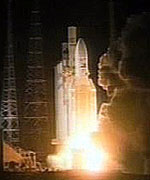
Image credit: Arianespace
Europe’s first mission to the Moon, SMART-1, lifted off successfully on board an Ariane-5 rocket Saturday evening. The rocket launched from the Guiana Space Centre at 2314 GMT (7:14 pm EDT) carrying SMART-1 and two other satellites. The spacecraft has deployed its solar arrays, and is currently undergoing an initial checkout of its systems to make sure that everything’s working properly. Its ion engine will begin accelerating the spacecraft towards the Moon on October 4th, but it’s going to be a long trip – it won’t arrive until March 2005.
SMART-1, Europe’s first science spacecraft designed to orbit the Moon, has completed the first part of its journey by achieving its initial Earth orbit after a flawless launch during the night of 27/28 September.
The European Space Agency’s SMART-1 was one of three payloads on Ariane Flight 162. The generic Ariane-5 lifted off from the Guiana Space Centre, Europe’s spaceport at Kourou, French Guiana, at 2014 hrs local time (2314 hrs GMT) on 27 September (01:14 Central European Summer time on 28 September).
42 minutes after launch, all three satellites had been successfully released into a geostationary transfer orbit (742 x 36 016 km, inclined at 7 degrees to the Equator). While the other two satellites are due to manoeuvre towards geostationary orbit, the 367 kg SMART-1 will begin a much longer journey to a target ten times more distant than the geostationary orbit: the Moon.
“Europe can be proud”, said ESA Director General Jean-Jacques Dordain, after witnessing the launch from ESA’s ESOC space operations centre in Darmstadt, Germany, “we have set course for the Moon again. And this is only the beginning: we are preparing to reach much further”.
The spacecraft has deployed its solar arrays and is currently undergoing initial checkout of its systems under control from ESA/ESOC. This checkout will continue until 4 October and will include with the initial firing of SMART-1’s innovative ion engine.
By ion drive to the Moon
Science and technology go hand in hand in this exciting mission to the Moon. The Earth and Moon have over 4 thousand million years of shared history, so knowing the Moon better will help scientists in Europe and all over the world to better understand our planet and will give them valuable new hints on how to better safeguard it” said ESA Director of Science David Southwood, following the launch from Kourou.
As the first mission in the new series of Small Missions for Advanced Research in Technology, SMART-1 is mainly designed to demonstrate innovative and key technologies for future deep space science missions.
The first technology to be demonstrated on SMART-1 will be Solar Electric Primary Propulsion (SEPP), a highly efficient and lightweight propulsion system that is ideal for long-duration deep space missions in and beyond our solar system. SMART-1’s propulsion system consists in a single ion engine fuelled by 82 kg of xenon gas and pure solar energy. This plasma thruster relies on the “Hall effect” to accelerate xenon ions to speed up to 16,000 km/hour. It is able to deliver 70 mN of thrust with a specific impulse (the ratio between thrust and propellant consumption) 5 to 10 times better than traditional chemical thrusters and for much longer durations (months or even years, compared to the few minutes’ operating times typical of traditional chemical engines).
The ion engine is scheduled to go into action on 30 September. At first, it will fire almost continuously “stopping only when the spacecraft is in the Earth’s shadow” to accelerate the probe (at about 0.2 mm/s2) and raise the altitude of its perigee (the lowest point of its orbit) from 750 to 20 000 km. This manoeuvre will take about 80 days to complete and will place the spacecraft safely above the radiation belts that surround the Earth.
Flight 162 ready for launch
Commissioning will be completed within 2 weeks, after which ESA’s control centre at ESOC will be in contact with the spacecraft for two 8-hour periods every week.
Once at a safe distance from Earth, SMART-1 will fire its thruster for periods of several days to progressively raise its apogee (the maximum altitude of its orbit) to the orbit of the Moon. At 200 000 km from Earth, it will begin receiving significant tugs from the Moon as it passes by. It will then perform three gravity-assist manoeuvres while flying by the Moon in late December 2004, late January and February 2005. Eventually, SMART-1 will be “captured” and enter a near-polar elliptical lunar orbit in March 2005. SMART-1 will then use its thruster to reduce the altitude and eccentricity of this orbit.
During this 18-month transfer phase, the solar-electric primary propulsion’s performance, and its interactions with the spacecraft and its environment, will be closely monitored by the Spacecraft Potential, Electron & Dust Experiment (SPEDE) and the Electric Propulsion Diagnostic Package (EPDP) to detect possible side-effects or interactions with natural electric and magnetic phenomena in nearby space.
A promising technology, Solar Electric Primary Propulsion could be applied to numerous interplanetary missions in the Solar System, reducing the size and cost of propulsion systems while increasing manoeuvring flexibility and the mass available for scientific instrumentation.
In addition to Solar Electric Primary Propulsion, SMART-1 will demonstrate a wide range of new technologies like a Li-Ion modular battery package; new-generation high-data-rate deep space communications in X and Ka bands with the X/Ka-band Telemetry and Telecommand Experiment (KaTE); a computer technique enabling spacecraft to determine their position autonomously in space, which is the first step towards fully autonomous spacecraft navigation.
Digging for the Moon’s remaining secrets
In April 2005 SMART-1 will begin the second phase of its mission, due to last at least six months and dedicated to the study of the Moon from a near polar orbit. For more than 40 years, the Moon has been visited by automated space probes and by nine manned expeditions, six of which landed on its surface. Nevertheless, much remains to be learnt about our closest neighbour, and SMART-1’s payload will conduct observations never performed before in such detail.
The Advanced/Moon Micro-Imaging Experiment (AMIE) miniaturised CCD camera will provide high-resolution and high-sensitivity imagery of the surface, even in poorly lit polar areas. The highly compact SIR infrared spectrometer will map lunar materials and look for water and carbon dioxide ice in permanently shadowed craters. The Demonstration Compact Imaging X-ray Spectrometer (D-CIXS) will provide the first global chemical map of the Moon and the X-ray Solar Monitor (XSM) will perform spectrometric observations of the Sun and provide calibration data to D-CIXS to compensate for solar variability.
The SPEDE experiment used to monitor Solar Electric Primary Propulsion interactions with the environment will also study how the solar wind affects the Moon.
The overall data collected by SMART-1 will provide new inputs for studies of the evolution of the Moon, its chemical composition and its geophysical processes, and also for comparative planetology in general.
Paving the way for future space probes
In addition to valuable lunar science, SMART-1’s payload will be involved in the mission’s technology demonstrations to prepare for future-generation deep space missions.
For instance, the AMIE camera will be used to validate the On-Board Autonomous Navigation (OBAN) algorithm, which correlates data from sensors and star trackers to provide navigational data. It will also participate in a laser communication link experiment with ESA’s optical ground station at the Teide Observatory in Tenerife, Canary Islands, trying to detect an incoming laser beam from the ground.
Using both AMIE and KaTE hardware, the Radio Science Investigation System (RSIS) experiment will demonstrate a new way of gauging the interiors of planets and their moons by detecting the well-known tilting motion of the Moon. This technology can be used later by ESA planetary missions.
SMART-1 was developed for ESA by the Swedish Space Corporation, as prime contractor, with contributions from almost 30 contractors from 11 European countries and the United States. Despite its small size, the spacecraft carries 19 kg of science payload consisting in experiments led by Principal Investigators from Finland, Germany, Italy, Switzerland and the United Kingdom.
Despite its relatively small budget and short development schedule, SMART-1 holds tremendous potential for future missions and is a clear illustration of Europe’s ambitions in the exploration of the solar system, also highlighted by June’s launch of Mars Express, which has now completed over the half on its journey to Mars, and the launch of Rosetta, due in February 2004, to visit comet Churyumov-Gerasimenko.
Original Source: ESA News Release
Book Review: A Short History of Nearly Everything
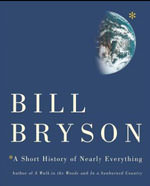
From the instant of the Big Bang to right now, A Short History of Nearly Everything by Bill Bryson chronicles how we ended up where we are – and how we figured it all out.
A Short History of Nearly Everything starts at the beginning, with the Big Bang, but then it starts to jump around following the connections of scientific discovery. For example, Clair Patterson finally discovered the age of the Earth in 1953. He made this discovery by assuming correctly that meteorites were formed at roughly the same time as the Earth, and since they didn’t come from the Earth, they couldn’t be contaminated with local minerals. But he based his discoveries on a technique of radioactive dating and knowledge that meteorites are rocks from space. And each of these discoveries are based on previous discoveries. And so on? and so on. Needless to say, there’s a lot of ground to cover. If you’ve ever seen James Burke’s “Connections”, you’ll have a better understanding of how this book is organized, jumping from concept to concept, stringing together the big picture.
Bryson wrote the book because he found that science textbooks state facts, like the Earth is 4.5 billion years old, but don’t really go into how these discoveries came about. How do we know this? Who were the scientists who made these discoveries in the first place? He set off to answer these questions and soon realized that our understanding of our place in the cosmos is based on a long series of discoveries, accidents, and meticulous research by countless scientists. That’s fine, lots of interconnected people, but what really convinced Bryson to write a 548-page book on the subject, however, is just how interesting some of those people were.
The book pauses on some of the more colourful characters of scientific discovery, such as arch-rival dinosaur hunters Edward Drinker Cope and Othniel Charles Marsh. Their bitter rivalry, which sometimes included throwing rocks at the other team, led to some of the most productive discoveries in paleontology. Or Fritz Zwicky, who coined the term “supernova”, and was notoriously aggressive – he’d drop and do one-armed pushups in front of anyone who didn’t think he was in shape. His own lab partner refused to work in the same room alone with him.
Bryson isn’t a scientist, he’s a writer, but he clearly did his homework over the course of the three years he took to put this book together. The writing is clear, entertaining, and never slips into industry jargon – if anything, Bryson underestimates the reader and explains some concepts a little more than he needs to. And this book is funny. I can’t remember the last time I ever laughed so much reading a book about science.
Bill Bryson sure picked a wide-ranging topic for his first science book, A Short History of Nearly Everything. But I’ve got to say, he really delivers the goods. It’s a great book – one of the most entertaining science books I’ve read in years.
Read more about the book at: Amazon.com – Amazon.ca – Amazon.co.uk
Boeing Picks Team Leader for JIMO Mission
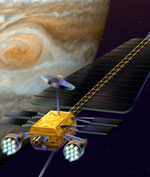
Image credit: NASA
Boeing has picked Dr. Joe Mills to lead their research into the Jupiter Icy Moons Orbiter program for NASA. This ambitious spacecraft will use a nuclear reactor to power an ion engine – it will be so powerful and efficient that it will be able to put itself into orbit around the various moons of Jupiter. The initial research phase is only a $6 million contract to investigate various technology options for the reactor, ion engine, and power conversion. NASA will choose a primary contractor for the mission in 2004.
Boeing [NYSE: BA] has selected Dr. Joe Mills to lead the company?s effort on the Jupiter Icy Moons Orbiter (JIMO) program, part of a NASA initiative to develop nuclear power and electric propulsion technologies to revolutionize space exploration.
Mills and his team will explore technology options for building the first spacecraft that would use nuclear electric propulsion. Boeing is one of three companies exploring technology options (called a Phase A study contract) for JIMO.
Mills previously headed the International Space Station (ISS) program for Boeing NASA Systems. The company is NASA?s prime contractor for the ISS and is responsible for design, construction, integration and operation of the orbital outpost.
?JIMO, like the International Space Station, is an exciting and groundbreaking mission,? said Mills, Boeing JIMO vice president and program manager. ?I?m looking forward to further challenges as we chart the course of space exploration in the 21st century.?
Mills will be replaced as the Boeing ISS vice president and program manager by John Elbon, who is the Boeing Checkout, Assembly and Payload Processing Services (CAPPS) manager at Kennedy Space Center, Fla.
Mills is an internationally known expert in the nuclear safety field with nearly 40 years experience in the aerospace industry. He received a bachelor of science degree in engineering in 1967, a master of science in nuclear engineering in 1969 and a doctorate in nuclear engineering in 1972, all from the University of California, Los Angeles.
Prior to joining the ISS program, Mills spent 20 years in a variety of project and program management positions with Atomics International, a part of Boeing Rocketdyne Propulsion and Power. From 1987 through 1994, he served as program manager to develop space nuclear power for key military and civilian missions.
Mills devoted his early career to nuclear power systems development. He also specialized in the nuclear safety field of liquid metal fast breeder reactors. He also published numerous papers on nuclear power systems and nuclear power safety.
The JIMO Phase A contract is valued at $6 million, with a $5 million option for further work, and runs through fall 2003. Led in this phase by Boeing Phantom Works, the company?s advanced R&D unit, the JIMO team will study technology options for the reactor, power conversion, electric propulsion and other subsystems of the JIMO spacecraft meant to explore the Jovian moons of Ganymede, Callisto and Europa.
NASA currently plans to select an industry prime contractor in fall 2004 to work with the Jet Propulsion Laboratory (JPL) in Pasadena, Calif., to develop, launch and operate the spacecraft.
Mills is responsible for successful execution of the Phase A trade and concept design study, as well as securing the contract to develop, build and support JPL in operation of the spacecraft. Mills leads the team from the Boeing office in Pasadena, Calif.
Mills reports to Mike Mott, NASA Systems vice president and general manager and Ron Prosser, vice president and general manager for Phantom Works Integrated Defense Advanced Systems.
Original Source: Boeing News Release
Dinosaurs Killed By Volcanoes and Asteroids?
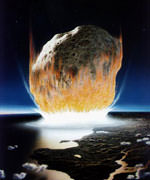
Image credit: NASA
Most paleontologist believe that a gigantic asteroid struck Mexico 65 million years ago and killed all the dinosaurs; end of story. But a minority believe that the Earth’s environment was already uncomfortable for dinosaurs because of a series of asteroid strikes and volcano eruptions – the asteroid was just the straw that broke the camel’s back. By studying the life spans of colonies of one-celled organisms, paleontologist Gerta Keller has uncovered that the Cretaceous period might have lasted 300,000 years after the asteroid impact.
As a paleontologist, Gerta Keller has studied many aspects of the history of life on Earth. But the question capturing her attention lately is one so basic it has passed the lips of generations of 6-year-olds: What killed the dinosaurs?
The answers she has been uncovering for the last decade have stirred an adult-sized debate that puts Keller at odds with many scientists who study the question. Keller, a professor in Princeton’s Department of Geosciences, is among a minority of scientists who believe that the story of the dinosaurs’ demise is much more complicated than the familiar and dominant theory that a single asteroid hit Earth 65 million years ago and caused the mass extinction known as the Cretacious-Tertiary, or K/T, boundary.
Keller and a growing number of colleagues around the world are turning up evidence that, rather than a single event, an intensive period of volcanic eruptions as well as a series of asteroid impacts are likely to have stressed the world ecosystem to the breaking point. Although an asteroid or comet probably struck Earth at the time of the dinosaur extinction, it most likely was, as Keller says, “the straw that broke the camel’s back” and not the sole cause.
Perhaps more controversially, Keller and colleagues contend that the “straw” — that final impact — is probably not what most scientists believe it is. For more than a decade, the prevailing theory has centered on a massive impact crater in Mexico. In 1990, scientists proposed that the Chicxulub crater, as it became known, was the remnant of the fateful dinosaur-killing event and that theory has since become dogma.
Keller has accumulated evidence, including results released this year, suggesting that the Chicxulub crater probably did not coincide with the K/T boundary. Instead, the impact that caused the Chicxulub crater was likely smaller than originally believed and probably occurred 300,000 years before the mass extinction. The final dinosaur-killer probably struck Earth somewhere else and remains undiscovered, said Keller.
These views have not made Keller a popular figure at meteorite impact meetings. “For a long time she’s been in a very uncomfortable minority,” said Vincent Courtillot, a geological physicist at Universit? Paris 7. The view that there was anything more than a single impact at work in the mass extinction of 65 million years ago “has been battered meeting after meeting by a majority of very renowned scientists,” said Courtillot.
The implications of Keller’s ideas extend beyond the downfall of ankylosaurus and company. Reviving an emphasis on volcanism, which was the leading hypothesis before the asteroid theory, could influence the way scientists think about the Earth’s many episodes of greenhouse warming, which mostly have been caused by periods of volcanic eruptions. In addition, if the majority of scientists eventually reduce their estimates of the damage done by a single asteroid, that shift in thinking could influence the current-day debate on how much attention should be given to tracking and diverting Earth-bound asteroids and comets in the future.
Keller does not work with big fossils such as dinosaur bones commonly associated with paleontology. Instead, her expertise is in one-celled organisms, called foraminifera, which pervade the oceans and evolved rapidly through geologic periods. Some species exist for only a couple hundred thousand years before others replace them, so the fossil remains of short-lived species constitute a timeline by which surrounding geologic features can be dated.
In a series of field trips to Mexico and other parts of the world, Keller has accumulated several lines of evidence to support her view of the K/T extinction. She has found, for example, populations of pre-K/T foraminifera that lived on top of the impact fallout from Chicxulub. (The fallout is visible as a layer of glassy beads of molten rock that rained down after the impact.) These fossils indicate that this impact came about 300,000 years before the mass extinction.
The latest evidence came last year from an expedition by an international team of scientists who drilled 1,511 meters into the Chicxulub crater looking for definitive evidence of its size and age. Although interpretations of the drilling samples vary, Keller contends that the results contradict nearly every established assumption about Chicxulub and confirm that the Cretaceous period persisted for 300,000 years after the impact. In addition, the Chicxulub crater appears to be much smaller than originally thought — less than 120 kilometers in diameter compared with the original estimates of 180 to 300 kilometers.
Keller and colleagues are now studying the effects of powerful volcanic eruptions that began more than 500,000 years before the K/T boundary and caused a period of global warming. At sites in the Indian Ocean, Madagascar, Israel and Egypt, they are finding evidence that volcanism caused biotic stress almost as severe as the K/T mass extinction itself. These results suggest that asteroid impacts and volcanism may be hard to distinguish based on their effects on plant and animal life and that the K/T mass extinction could be the result of both, said Keller.
Original Source: Princeton News Release
Up Next, Mars Reconnaissance Orbiter
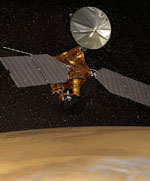
Image credit: NASA/JPL
Earth’s closest approach to Mars is past, but it’ll just be another two years until the planets are close together again – time to send more probes. Next up will be NASA’s Mars Reconnaissance Orbiter, which will make a detailed inspection of the Martian surface; imaging objects as small as a coffee table. It will also be able to scan underground layers for evidence of water and ice, and measure the atmosphere above the surface to find vents of water vapour escaping from below the surface. The spacecraft is expected to launch on August 10, 2005.
As Earth pulls away from Mars after last month’s close approach, NASA is developing a spacecraft that will take advantage of the next close encounter in 2005.
That spacecraft, Mars Reconnaissance Orbiter, will make a more comprehensive inspection of our planetary neighbor than any previous mission.
For starters, it will examine landscape details as small as a coffee table with the most powerful telescopic camera ever sent to orbit a foreign planet. Some of its other tools will scan underground layers for water and ice, identify small patches of surface minerals to determine their composition and origins, track changes in atmospheric water and dust, and check global weather every day.
“We’re reaching an important stage in developing the spacecraft,” said James Graf, project manager for Mars Reconnaissance Orbiter at NASA’s Jet Propulsion Laboratory, Pasadena, Calif. “The primary structure will be completed next month.” The structure weighs 220 kilograms (484 pounds) and stands 3 meters (10 feet) tall. At launch, after gear and fuel are added, it will support over 2 tons.
Also next month, the mission’s avionics test bed will be assembled for the first time and put to use for testing of flight software.
Workers at Lockheed Martin Space Systems, Denver, have already assembled the spacecraft structure and will later add instruments being built for it at the University of Arizona, Tucson; at Johns Hopkins University Applied Physics Laboratory, Laurel, Md.; at the Italian Space Agency, Rome; at Malin Space Science Systems, San Diego, Calif.; and at JPL.
“In several ways, Mars Reconnaissance Orbiter will advance NASA’s follow-the-water strategy for Mars exploration,” said Dr. Richard Zurek, project scientist for the mission.
Current surveys of Mars’ surface composition have found less evidence of water-related minerals than many scientists anticipated after earlier discoveries of plentiful channels that were apparently carved by water flows in the planet’s past. A spectrometer on the Reconnaissance Orbiter is designed to identify some different types of water-related minerals and to see smaller-scale deposits. “Instead of looking for something as big as the Bonneville Salt Flats, we can look for something on the scale of a Yellowstone hot spring,” Zurek said.
Probing below Mars’ surface with penetrating radar, Reconnaissance Orbiter will check whether the frozen water that NASA’s Mars Odyssey spacecraft detected in the top meter or two (yard or two) of soil extends deeper, perhaps as accessible reservoirs of melted water.
Above the surface, an atmosphere-scanning instrument will monitor changes in water vapor at different altitudes and might even locate plumes where water vapor is entering the atmosphere from underground vents, if that’s happening on Mars.
Mars Reconnaissance Orbiter will stream home its pictures and other information using the widest dish antenna and highest power level ever operated at Mars. “The amount of data flowing back to Earth from Mars will be a giant leap over previous missions. It’s like upgrading from a dial-up modem for your computer to a high-speed DSL connection,” Graf said.
The Mars Reconnaissance Orbiter will lay the groundwork for later Mars surface missions in NASA’s plans: a lander called Phoenix selected last month in a competition for a 2007 launch opportunity, and a highly capable rover called Mars Science Laboratory being developed for a 2009 launch opportunity. The orbiter’s high-resolution instruments will help planners evaluate possible landing sites for these missions both in terms of science potential for further discoveries and in terms of landing risks. The orbiter’s communications capabilities will provide a critical transmission relay for the surface missions.
Advantageous opportunities to launch Mars missions come in a rhythm of about every 26 months, shortly before each time Earth overtakes Mars in the two planets’ concentric tracks around the Sun. NASA’s two Mars Exploration Rovers and the European Space Agency’s Mars Express mission were launched during the three months preceding Earth’s most recent passing of Mars on Aug. 27. The Mars Reconnaissance Orbiter team has its work cut out for it to have the spacecraft ready for launch on Aug. 10, 2005, which is about 10 weeks before the next close approach.
Original Source: NASA/JPL News Release
Lance Bass Will Join World Space Week

Image credit: World Space Week
He didn’t quite make it up the International Space Station, but Lance Bass, member of the Pop music group NSYNC is still interested in space. He’s going to be visiting schools in the Houston area during World Space Week (October 4-10, 2003) to help promote to children that science and math are “cool”. World Space Week was declared by the United Nations in 1999 and is celebrated in nearly 50 countries around the world. Many other events are planned for the week, including a webcast from the space station, giving people a chance to chat with the astronauts.
One year after completing his spaceflight training here, entertainer, certified cosmonaut and World Space Week 2003 Youth Spokesperson Lance Bass will return to Houston with a new, yet equally challenging mission: to convince young people that space, math and science are “cool.”
Bass will visit several Houston primary and secondary schools during World Space Week, October 4-10, to discuss the importance of science and math. He will review students’ design proposals for “Lance’s Lab,” a global youth competition in which the engineers and explorers of tomorrow design a hypothetical space station module for Bass to live and work in.
“I’m very excited about flying in space one day,” said Bass, member of popular band *NSYNC and avid space enthusiast. “What excites me even more is the possibility that eventually, nearly anyone will be able to travel in space just as easily as taking a plane from LA to Houston. But that day will only arrive if today’s young people choose to build an extraordinary future for themselves. The keys to that future are a solid foundation in math and science”
To conclude World Space Week on Friday, Bass will attend a public event that salutes the benefits space exploration brings to education and all aspects of life on Earth. The World Space Week Celebration, starting at 7 p.m. CT on October 10 at the Hyatt Downtown Houston, will support Spaceweek International Association’s programs to excite students about math and science. Celebration-goers will meet Bass, along with Houston Congressman Nick Lampson and other celebrities. Tickets are on sale to the public and can be purchased at www.spaceweek.org.
“Bass’ visits to schools will offer students and teachers the opportunity to create a renewed passion and understanding for the horizons that can be explored with math and science,” said Dennis Stone, president of Spaceweek International Association.
Declared by the United Nations, World Space Week is held October 4 – 10 each year and is marked by celebrations on all seven continents. This year, nearly 50 nations around the world are expected to participate. Events in the United States will focus on the vital role math and science education play in creating tomorrow’s space leaders and pioneers. Highlights include:
- Teachers across the U.S. will use space in the classroom all week long to excite students about science and math;
- NASA will host a Web cast from the International Space Station (ISS), October 9 at 12 p.m. CT, with an opportunity to ask questions of an ISS astronaut;
- Earth & Sky Radio will host World Space Week radio broadcasts on October 7 and 10;
- The Space Frontier Foundation will hold the “Alt.Space” conference on October 10 in Los Angeles;
- The Iowa Space Grant Consortium will host a Space Week Science Challenge from October 4-10;
- The Museum of Texas Tech University will feature a World Space Week celebration on October 4.
For detailed information on events and celebrations across the globe, visit www.spaceweek.org.
About Lance’s Lab
“Lance’s Lab” is a global youth competition, in which K-12 students are asked to design a hypothetical International Space Station module for Bass to live and work in. Lance’s Lab is a worldwide student contest that underscores the fundamental importance of math and science. Winners will meet Bass at an awards ceremony in early 2004.
Special instructional materials are available to schools at no charge, featuring space-related math and science activities for teachers to use during World Space Week. Materials are available in several languages with activities for all grade levels and require little or no teacher preparation. By participating in World Space Week, teachers can excite students about learning and receive cash grants. For details or to download educational materials, visit: www.spaceweek.org/education.html
About World Space Week
From the United States to Bangladesh, from Columbia to China, World Space Week is celebrated annually in some 50 nations, on all seven continents. It serves to celebrate the contributions of space science and technology to the betterment of the human condition.
Declared in 1999 by the UN General Assembly, World Space Week marks the anniversary of two great milestones of humanity’s expansion into space:
- 4 October 1957 — Date of the launch into outer space of the first human-made Earth satellite, SPUTNIK I, thus opening the way for space exploration;
- 10 October 1967 — Date of the entry into force of the Treaty on Principles Governing the Activities of States in the Exploration and Peaceful Uses of Outer Space, including the Moon and Other Celestial Bodies
Founded in 1981, Spaceweek International Association (SIA) is non-profit organization that proudly supports the United Nations in the global coordination of World Space Week. SIA works to strengthen the link between space and society through public education, participation, and dialogue on the future of space.
Original Source: World Space Week News Release
Hoping for a Supernova
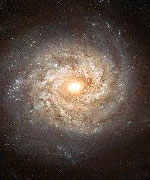
Image credit: Hubble
Astronomers from the European Space Agency are tracking hundreds of galaxies with the Hubble Space Telescope, hoping that one or more stars will eventually explode as a supernova. They can then look back through the data and find the individual star that exploded – this would mean it was in the final stages of its life. So far, supernova have only been tracked back to two “mother stars” so far, so astronomers really need more of this data to help understand the conditions that cause a star to go supernova.
A team of European astronomers is using the NASA/ESA Hubble Space Telescope to look back in time. They have imaged the spiral galaxy NGC 3982 and hundreds of other galaxies in the hope that one of the millions of stars in these images will some day explode as a supernova. They can then look back and pinpoint the exact star that has exploded. Only two such supernova ‘mother stars’ have ever been identified.
The fantastic resolution of the Hubble Space Telescope allows individual massive stars in other galaxies to be detected. A team from Cambridge and Trieste have used Hubble and ESO?s Very Large Telescope to image NGC 3982 and several hundred other nearby galaxies in the hope that a few of the stars in these images will explode as supernovae in the future.
When a star of more than 10 times the mass of our Sun reaches the end of its nuclear fuel reserve, it can no longer produce enough energy to keep it from collapsing under its own immense weight. The core of the star collapses, and the outer layers are ejected in a fast-moving shock wave. These supernova explosions are at the heart of our understanding of the evolution of galaxies and the formation of the chemical elements in the Universe. Yet astronomers have been able to identify only two stars that later exploded as supernovae with any confidence.
Supernovae have many different characteristics and understanding exactly which type of star produces which kind of supernova is a fundamental challenge. To find these supernova ‘mother stars’, the team has undertaken this intensive study of the nearby Universe and is now playing a waiting game.
It appears that typical spiral galaxies produce one supernova roughly every 100 years and so the team has to study a large number of galaxies to stand a chance of being lucky enough to catch a star before it destroys itself and becomes either a neutron star or a black hole.
By using the most powerful telescopes both in space and on the ground to take images at different optical and infrared wavelengths, the temperature, luminosity, radius and mass of the stars that later explode can be estimated. This will allow astronomers to see exactly which types of stars produce supernovae and to test if their theories for the origins of these cosmic explosions are correct.
The beautiful galaxy NGC 3982 is a typical spiral galaxy and looks just as our own galaxy, the Milky Way, would if we could view it face on. It harbours a huge black hole at its core and has massive regions of star formation in the bright blue knots in the spiral arms. Supernovae are most likely to be found within these energetic regions.
Original Source: ESA News Release
